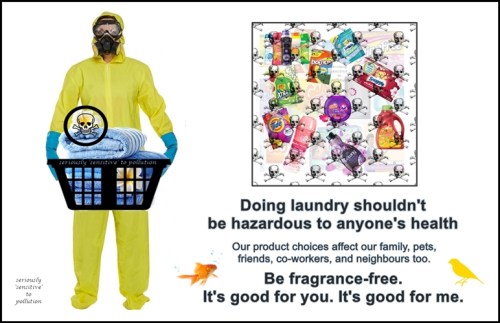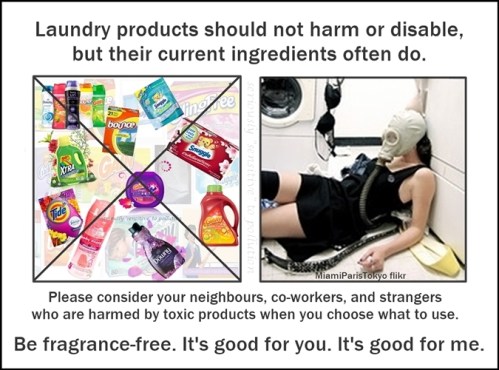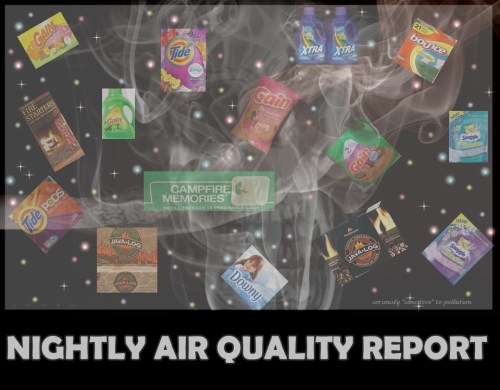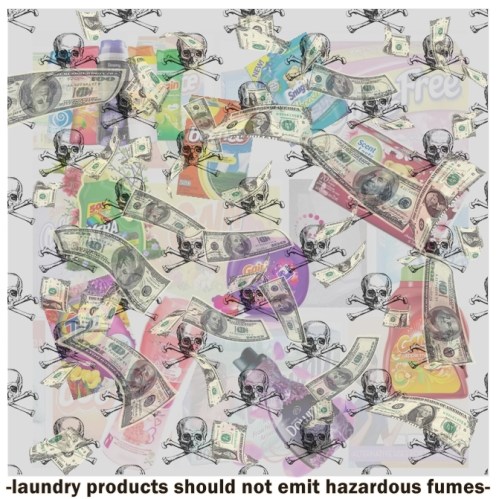We often hear from people who think they aren’t wearing any fragrance while their fume trail is noticeable (and headache inducing or worse) from 100 feet away. Not only that, but the scent residues are left everywhere these people have touched anything, including pretty much permanently in the furniture they’ve used.
How can this be?
Laundry products!
…
As if the regular fragranced laundry products weren’t bad enough, in recent years manufacturers have been inventing scent boosters and prolonging the fragrances with who knows what kinds of secret, unregulated chemicals.
One of the biggest complaints I hear about from people who have chemical and/or environmental ‘sensitivities’ is how laundry products have caused countless health and accessibility problems.
Health problems like headaches, nausea, rashes, asthma attacks, migraines, dizziness, seizures, anaphylaxis, confusion, cognitive issues, brain fog, memory problems, some can clear up quickly, but others can last for days if not longer!
Accessibility problems like:
having to avoid the laundry aisles in stores,
not being able to enter stores that have laundry aisles,
not being able to eat any food from a store that has a laundry aisle because all the food tastes like laundry products,
not being able to shop for second hand clothing (or bring anything 2nd hand home),
not being able to open windows or be outside without being made ill or disabled,
losing jobs because co-workers were so attached to their products,
not being able to hug loved ones on their births or deathbeds,
not being able to receive health care because the care providers clothing was emanating toxic fumes…
and the lists go on.
Laundry products are harming humans and this is not right!
If adult humans are being harmed, you can be sure that birds, fish, pets, and other beings are also being harmed, but since we (or the regulators) did not act when the signs were pointing out those consequences, we now have countless people being affected.
Children won’t be able to tell you what effects these products are having on them, so unless they are visible like rashes, you won’t be able to figure out that the anxiety, the acting out, the memory problems, etc may be connected to these products that they have 24/7 contact with, but it only makes sense that since children are more vulnerable, and 34.7% of adults are adversely affected by fragranced products, that a higher percentage of children will be affected.
Laundry products need to be specifically included in fragrance-free policies.
…
…
Here’s more bad news:
While fragrances are hugely problematic, it’s not just about fragrance!
Toxic chemicals are used in fragrance-free products too!
About Those Fragrance-Free Laundry Products
That same study found that green or organic products with essential oils fared no better as far as releasing harmful chemicals into the air!
…
This post lists some of the ingredients and effects in detail:
Toxic Chemicals in Fragranced Laundry Products and Health Effects
…
Laundry products are a growing contributor to outdoor air pollution too. A recent study from NOAA listed them among the household products that now release as much pollution as vehicle exhaust!
Scented laundry products emit hazardous chemicals through
dryer vents
https://www.sciencedaily.com/releases/2011/08/110824091537.htm
Toxic chemicals in everyday laundry products!?!
(some links in that post may no longer work)
…
When manufacturers are currently not being stopped from creating and selling health harming products, because the regulations tend to protect them instead of us, it’s up to us to stop the harm ourselves.
When we choose non-toxic, fragrance-free products,
then all living beings benefit!
♥
The change will be worth it!









I was hurt to find this week that my neighbourhood Metro is now using scented grocery bags home with my fresh fruit and veggies in them. No wonder I was sick and exhausted by the time I got them home. I’ve had a cold so I didn’t notice until the next day when I opened the cupboard where I stored the things. To add insult to injury, I paid $0.05 apiece for the privilege of being assaulted. I can avoid the laundry isle, I can walk away from ignorant people pickled in fragrances, but I can’t avoid checking out my groceries through the cash. Another store bites the dust!
If it’s just the bags, can you use your own cloth bags?
Thank you for another great post! My sister had a rash over 80% of her body that wouldn’t go away– a big part of the cause was laundry detergent. She eliminated her laundry detergent but it took a long time to get it out of her clothes. The whole ordeal lasted a year. Laundry detergent contains serious chemicals that are not safe for people or the environment.
If or when people do develop adverse health effects from laundry products, it shouldn’t be necessary to go to the effort and expense of hundreds of loads of laundry in an effort to remove the residues, while still suffering the health effects, or to have to discard all clothing, bedding, furniture, and carpeting too because the products are so difficult or impossible to remove!!
No manufacturer has been able to let us know how to remove all traces of their products if someone is suffering harm from them, because in many cases, it just can’t be done! They need to be called to account for this too!
SUPERB! Just shared on FB. THANK YOU for your always excellently researched & documented posts!
At a picnic recently I had to keep moving to get away from the smell of laundry detergent from other people’s picnic rugs.
On another occasion when I went to someone’s house all I could smell outside was laundry detergent, I didn’t stay long.
At my local Foodland supermarket the cling wrap on fresh food packed in-store always smells of laundry detergent.
I host international students and often when they first arrive their clothes smell heavily of laundry detergent as the chemicals have been trapped inside their suit cases. As soon as they open their cases the smell wafts out and seeps into every corner of the house. It takes about a week for the smell to dissipate and several washes before it’s out of their clothes.
After a flight home I had to wash all my clothes as they smelt of fragrance. It must have seeped in to my bag while in transit from other people’s luggage.
It has become a global problem!
Clean has no smell!
Great article. Poor kids! Makes you wonder about the rise in attention deficit and autistic children etc., recently doesn’t it? Poor parents how will they feel when they finally realize that they may inadvertantly have been causing these illnessses and/or conditions in their children by using products they have been led to believe are harmless!
God bless you Linda for helping so many by raising awareness and helping us all to be so well informed ♡♡♡
Thanks Therese. But… it wouldn’t be the parents’ fault, the fault lies directly with the corporations and regulators.
Most parents have no way of knowing this. They think things have to be proven safe to be sold… The media rarely says anything, and then it gets buried… The ingredients aren’t on labels (hence the recent pushes to get clear labeling laws enacted)… The corporations have multi million dollar advertising campaigns, using psychological tricks to manipulate people… It’s going to take some people with more clout to get to the public, unless more of us speak out and demand action instead of quietly disappearing from life!
Pingback: Your Very Own Neighbourhood Chemical Distribution Device | Seriously "Sensitive" to Pollution
Pingback: Product Safety Gaps are Actually Canyons | Seriously "Sensitive" to Pollution
2020 Jan 3[Online ahead of print]
Contact Allergens in Top-Selling Textile-care Products
Heidi Bai 1 , Idy Tam 2 , JiaDe Yu 3 4
Affiliations
Abstract
Background: Chemicals in textile manufacturing and laundering products are important sources of allergens triggering allergic contact dermatitis. Allergens corresponding to the textile production process have been well recognized. However, there is limited information regarding potential allergens in laundering products.
Objective: The aim is to investigate the presence and prevalence of potential allergens in commonly used laundering products.
Methods: An Internet-based search was performed to identify the current best-selling laundering products in the United States. Subsequent inquiry of common allergens for each product was collected through a review of ingredients listed by manufacturers.
Results: Sixty-five laundering products were examined: 30 laundry detergents, 10 fabric softeners, 8 dryer sheets, and 17 stain removers. Ten common allergens were identified: benzisothiazolinone, benzyl benzoate, cocamidopropyl betaine, decyl glucoside, “fragrances,” lauryl glucoside, methylisothiazolinone, methylchloroisothiazolinone, phenoxyethanol, and propylene glycol. Fragrances and essential oils are the top allergens in laundry detergents (66.7%), fabric softeners (90%), dryer sheets (75%), and stain removers (58.8%). Laundry detergents labeled as “baby safe” and “free and gentle” contained common allergens, with methylisothiazolinone being the most prevalent, in 80% and 57.1%, respectively.
Conclusions: Textile dermatitis can negatively impact quality of life and function. Aside from textile dyes and finishing resins, laundering products should also be considered.
https://pubmed.ncbi.nlm.nih.gov/31905182-contact-allergens-in-top-selling-textile-care-products/
Pingback: Two Tales: Temporarily Quarantined or Isolated Forever | Seriously "Sensitive" to Pollution